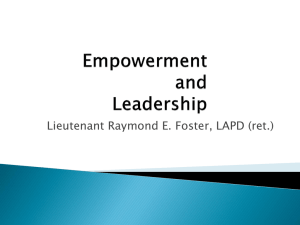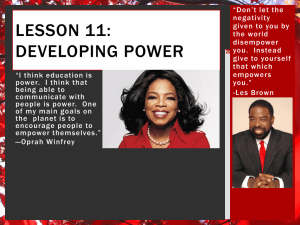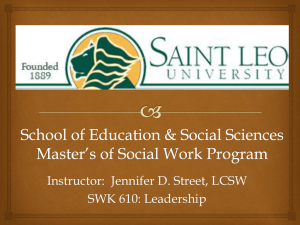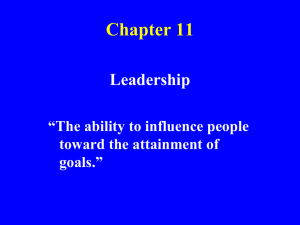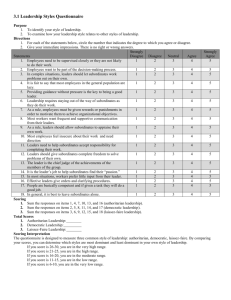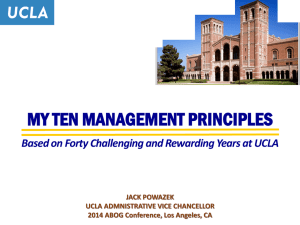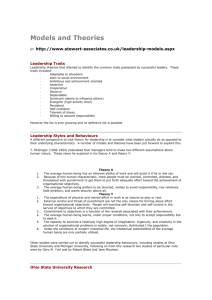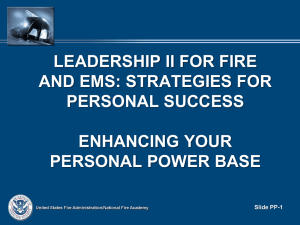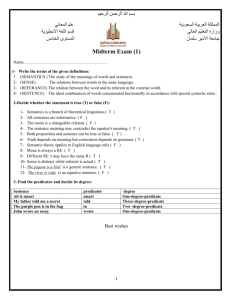CHAPTER 16 - UPM EduTrain Interactive Learning
advertisement
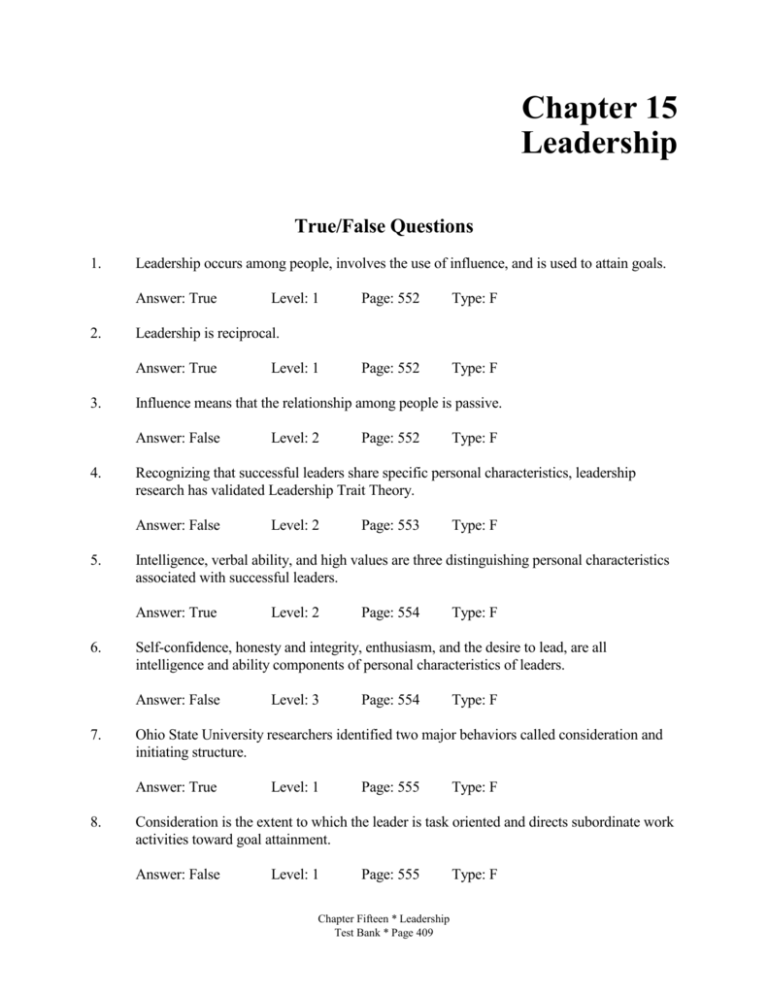
Chapter 15 Leadership True/False Questions 1. Leadership occurs among people, involves the use of influence, and is used to attain goals. Answer: True 2. Level: 2 Page: 552 Type: F Level: 2 Page: 553 Type: F Level: 2 Page: 554 Type: F Level: 3 Page: 554 Type: F Ohio State University researchers identified two major behaviors called consideration and initiating structure. Answer: True 8. Type: F Self-confidence, honesty and integrity, enthusiasm, and the desire to lead, are all intelligence and ability components of personal characteristics of leaders. Answer: False 7. Page: 552 Intelligence, verbal ability, and high values are three distinguishing personal characteristics associated with successful leaders. Answer: True 6. Level: 1 Recognizing that successful leaders share specific personal characteristics, leadership research has validated Leadership Trait Theory. Answer: False 5. Type: F Influence means that the relationship among people is passive. Answer: False 4. Page: 552 Leadership is reciprocal. Answer: True 3. Level: 1 Level: 1 Page: 555 Type: F Consideration is the extent to which the leader is task oriented and directs subordinate work activities toward goal attainment. Answer: False Level: 1 Page: 555 Chapter Fifteen * Leadership Test Bank * Page 409 Type: F 9. Initiating structure is the extent to which the leader is mindful of subordinates, respects their ideas and feelings, and establishes mutual trust. Answer: False 10. Level: 2 Page: 557 Type: F Level: 3 Page: 557 Type: F Level: 2 Page: 558 Type: F Level: 2 Page: 559 Type: F Level: 2 Page: 559 Type: F According to Fiedler, the task-oriented leader excels in the favorable situation whereas relationship-oriented leaders are most effective in situations of moderate favorability. Answer: True 18. Level: 2 Task Structure refers to the extent to which the leader has formal authority over subordinates. Answer: False 17. Type: F According to Fiedler, leader-member relations, task structure and task consideration are the three factors that combine to determine the leadership situation. Answer: False 16. Page: 556 To match the leader's style with the situation by changing factors in the situation to achieve the best match is the basic idea with Fiedler's contingency theory. Answer: True 15. Type: F The country club management style (1,9) stresses high service and concern for guests or customers, sometimes to the detriment of employees of the firm. Answer: False 14. Page: 556 Job-centered leaders are those leaders that establish high performance goals and display supportive behavior toward subordinates. Answer: False 13. Type: F The leaderhsip grid suggests a two-dimensional leadership theory that measures a leader's concern for people and concern for production. Answer: True Level: 3 12. Page: 556 Ohio State's "high-high" style is not always the best, according to new research. Answer: True 11. Level: 1 Level: 2 Page: 560 Type: F Hersey and Blanchard's situational theory focuses a great deal of attention on the characteristics of employees in determining appropriate leadership behavior. Chapter Fifteen * Leadership Test Bank * Page 410 Answer: True 19. Type: F Level: 2 Page: 564 Type: F Level: 2 Page: 564 Type: F Level: 1 Page: 565 Type: F Level: 2 Page: 567 Type: F Level: 2 Page: 567 Type: F A transactional leader is an inspirational leader who has the ability to motivate subordinates, through personal transactions, to transcend their normal performance. Answer: False 27. Page: 563 A neutralizer is a situational variable that counteracts a leadership style and prevents the leader from displaying certain behaviors. Answer: False 26. Level: 2 A substitute counteracts the leadership style and prevents the leader from displaying certain behaviors. Answer: False 25. Type: F The work environment contingencies, according to the Path-Goal theory, include the degree of task structure, the nature of the formal authority system, and the work group itself. Answer: True 24. Page: 563 If someone believes in telling their subordinates exactly what they are supposed to do, then they are exercising a supportive leader behavior, according to the Path-Goal theory. Answer: False 23. Level: 2 The leader can increase employee motivation, according to the Path-Goal theory, by either (1) clarifying the employee's path to accomplish goals, or (2) maximizing the value of the rewards available to successful employees. Answer: True 22. Type: F According to Hersey and Blanchard, the telling style is appropriate for followers with moderate readiness. Answer: False 21. Page: 562 Situational theory model is easier to understand than Fiedler’s model, but it incorporates only the characteristics of followers, not those of the situation. Answer: True 20. Level: 2 Level: 2 Page: 568 Type: F A transformational leader is a leader distinguished by a special ability to bring about innovation and change. Chapter Fifteen * Leadership Test Bank * Page 411 Answer: True 28. Level: 1 Page: 572 Type: F Level: 2 Page: 572 Type: F Level: 2 Page: 572 Type: A Level: 2 Page: 572 Type: F Level: 1 Page: 572 Type: F Level: 1 Page: 573 Type: F Empowering employees works because total power in the organization seems to increase. Answer: True 37. Type: F Referent power is the type of power that results from political referrals. Answer: False 36. Page: 572 Two types of personal powers are expert and reward powers. Answer: False 35. Level: 1 The powers most likely to generate resistance from employees are legitimate and reward powers. Answer: False 34. Type: F When Bob shouts at Tara in public for not finishing her work and suspends her for two days, he is using his coercive power. Answer: True 33. Page: 571 The type of power that results from the leader's legitimate authority, based upon his or her position within the organization, is called coercive power. Answer: False 32. Level: 1 Legitimate, reward, and expert powers are all forms of position power. Answer: False 31. Type: F Mechanistic power is one of the five sources of power. Answer: False 30. Page: 570 The potential ability to influence the behavior and decisions of other people is power. Answer: True 29. Level: 1 Level: 2 Page: 573 Type: F Given that everyone has more say and it takes more time, empowering employees has been on decline in corporate America. Answer: False Level: 2 Page: 573 Chapter Fifteen * Leadership Test Bank * Page 412 Type: F 38. A servant leader is a leader who works to fulfill subordinates needs and goals as well as to achieve the organization’s larger mission. Answer: True Level: 1 Page: 574 Type: F Multiple Choice Questions 1. The ability to influence people toward the attainment of organizational goals is known as a. b. c. d. e. motivation. leadership. persuasion. commitment. organizational citizenship. Answer: b 2. Type: F influence. people. goals. coercive power. a and b only. Answer: d Level: 1 Page: 552 Type: F Leadership is reciprocal, according to your text. This means a. b. c. d. e. it is dynamic. it is a problem-solving activity. it occurs between people. redundant. it always creates conflict. Answer: c 4. Page: 552 All of the following are essential parts of any definition of leadership EXCEPT a. b. c. d. e. 3. Level: 1 Level: 2 Page: 552 Type: F Raj has the ability to convince others to work toward organizational objectives. This ability is known as a. b. c. d. motivation. leadership. commitment. a conceptual skill. Chapter Fifteen * Leadership Test Bank * Page 413 e. personal agenda. Answer: b 5. Level: 1 Page: 553 Type: F The early research on leadership traits was referred to as the a. b. c. d. e. contingency theory of leadership. path-goal theory of leadership. great man approach. situational theory of leadership. behavioral approach. Answer: c Level: 2 In general, research has found a success. a. b. c. d. e. Page: 553 Type: F relationship between personal traits and leader strong weak positive negative inverse Answer: b 8. Type: A traits. sources of power. leadership styles. leadership behaviors. personal preferences. Answer: a 7. Page: 552 The distinguishing personal characteristics of a leader are known as a. b. c. d. e. 6. Level: 2 Level: 2 Page: 553 Type: F Recently, Collie Care was attempting to hire a middle manager. They were looking for an intelligent, active, and creative individual. Which approach to leadership was Collie using? a. b. c. d. e. The contingency approach The situational approach The trait approach The behavioral approach The substitute approach Answer: c Level: 2 Page: 553 Chapter Fifteen * Leadership Test Bank * Page 414 Type: A 9. Which of the following characteristics of leaders have been studied? a. b. c. d. e. Personality traits Physical traits Social traits Work-related traits All of the above Answer: e 10. Level: 3 Page: 554 Type: F Self-confidence, honesty and integrity, and the desire to lead, are all components of which personal characteristic of leaders? a. b. c. d. e. Physical characteristics Intelligence and Ability Personality Social Characteristics Social Background Answer: c Level: 2 Page: 554 Type: F Janelle Jenkins at CompuSync show vast knowledge, intelligence, cognitive ability, and keen decisiveness. Which personal characteristic of leadership is she showing? a. b. c. d. e. Physical characteristics Intelligence and Ability Personality Social Characteristics Social Background Answer: c 13. Type: F the organization. the subordinate. the leader. the competitors.. b and c only. Answer: d 12. Page: 553 The effectiveness and appropriateness of a set of leader traits depends on all of these EXCEPT a. b. c. d. e. 11. Level: 2 Level: 2 Page: 554 Type: A Researchers at the Ohio State University identified two major behaviors called Chapter Fifteen * Leadership Test Bank * Page 415 a. b. c. d. e. commitment and consideration. commitment and initiation. consideration and initiating structure. initiating structure and commitment. consideration and concern for people. Answer: c 14. Level: 2 Page: 555-556 Type: A ______ is consistent with initiating structure. a. b. c. d. e. Task oriented behavior Open communication Teamwork oriented People oriented behavior Country-club management style Answer: a Level: 2 Page: 556 Type: F According to research conducted at the Ohio State University, which of the following combinations produced the highest levels of performance and satisfaction? a. b. c. d. e. High consideration and low initiating structure High consideration and high commitment High initiating structure and high consideration High initiating structure and high commitment Low consideration and low initiating structure Answer: c 17. Type: F high in initiating structure. low in initiating structure. high in consideration. a team leader. task-oriented manager. Answer: c 16. Page: 555 Bernetta is a manager at Winans International. She is very friendly and extremely respectful of her subordinate's welfare. She can be described as a. b. c. d. e. 15. Level: 2 Level: 2 Page: 556 Type: F According to the most recent research on the leader behaviors of consideration and initiating structure, which of the following combinations is best? a. b. c. High consideration and high initiating structure High consideration and low initiating structure Low consideration and high initiating structure Chapter Fifteen * Leadership Test Bank * Page 416 d. e. Low consideration and low initiating structure None of the above; no one style is best. Answer: e 18. Page: 556 Type: F The Michigan researchers used the term for leaders who established high performance goals and displayed supportive behavior toward subordinates. a. b. c. d. e. job-centered leaders employee-centered leaders initiating structure consideration impoverished management Answer: b 19. Level: 3 Level: 2 Page: 556 Type: F The less effective leaders, in the University of Michigan studies, were called a. b. c. d. e. job-centered leaders. employee-centered leaders. initiating structure. consideration. impoverished management. Answer: a 20. and Level: 2 Page: 556 Type: F proposed a two dimensional leadership theory called the Leadership Grid. a. b. c. d. e. Blake; Mouton Hersey; Blanchard Vroom; Yetton Tannenbaum; Schmidt Evans; House Answer: a 21. Level: 1 Page: 556 Type: F The recommended management style from the leadership grid is a. b. c. d. e. 1,9. 9,1. 5,5. 1,1. 9,9. Answer: e Level: 2 Page: 556 Chapter Fifteen * Leadership Test Bank * Page 417 Type: F 22. According to the leadership grid, which of these is a 1,9 management style? a. b. c. d. e. Team Management Country Club Management Middle of the Road Management Impoverished Management Authority-Compliance Answer: b 23. Level: 2 Page: 556 Type: F ______, according to the Leadership Grid, occurs when efficiency in operations is the dominant orientation. a. b. c. d. e. Team Management Country Club Management Middle of the Road Management Impoverished Management Authority-Compliance Answer: e Level: 2 Page: 556 Type: F The Leadership Grid used the two leader behaviors which were called a. b. c. d. e. employee-centered and job centered. consideration and initiating structure. concern for people and concern for production. relationship-oriented and task-oriented. employee-oriented and relationship oriented. Answer: c 26. Type: F Team Management Country Club Management Middle of the Road Management Impoverished Management Authority-Compliance Answer: c 25. Page: 556 Which Management style reflects a moderate amount of concern for both people and production? a. b. c. d. e. 24. Level: 1 Level: 1 Page: 557 The path-goal theory was presented by a. Fred Fiedler. Chapter Fifteen * Leadership Test Bank * Page 418 Type: F b. c. d. e. Hersey and Blanchard. Blake and Mouton. Evans and House. None of the above. Answer: d 27. Level: 1 Page: 558 Type: F LPC refers to a. b. c. d. e. lowest potential coworker. least preferred coworker. leadership preparedness of coworker. least prepared coworker. low pay checked individual. Answer: b Level: 1 Page: 559 Type: F Two leadership styles used by Fiedler in his contingency theory were a. b. c. d. e. employee-centered and job-centered. consideration and initiating structure. concern for people and concern for production. relationship-oriented and task-oriented. employee-oriented and relations-oriented. Answer: d 30. Type: F Contingency approach Behavioral approach Trait approach Organizational approach None of the above Answer: a 29. Page: 558 ______ is a model of leadership that describes the relationship between leadership styles and specific organizational situations. a. b. c. d. e. 28. Level: 2 Level: 1 Page: 559 Type: F __________ refers to group atmosphere and members’ attitude toward and acceptance of the leader. a. b. c. d. e. Task structure Leader relations Contingency Position power Leader-member relations Chapter Fifteen * Leadership Test Bank * Page 419 Answer: e 31. Level: 2 Page: 559 Type: F The extent to which tasks performed by the group are defined, involve specific procedures, and have clear, explicit goals is called a. b. c. d. e. task structure. leader relations. contingency. position power. leader-member relations. Answer: a Level: 2 Page: 559 Type: F According to Fiedler, in situations of ______, relationship-oriented leaders are more effective. a. b. c. d. e. high favorability moderate favorability high unfavorability no favorability none of the above Answer: b 34. Type: F leader-member relations. task structure. personal power. position power. all of the above were used by Fiedler to describe the situation. Answer: c 33. Page: 559 Fiedler used all of the following to describe the situation EXCEPT a. b. c. d. e. 32. Level: 2 Level: 2 Page: 560 Type: F The key assumption of Hersey and Blanchard's situational theory is that subordinates vary in their a. b. c. d. e. readiness level. satisfaction level. level of commitment. level of security. all of the above. Answer: a Level: 2 Page: 562 Chapter Fifteen * Leadership Test Bank * Page 420 Type: F 35. Hersey and Blanchard are responsible for which theory? a. b. c. d. e. Theory of leadership ERG Theory Situational theory Contingency theory Leadership Answer: c 36. Level: 2 Page: 562 Type: F Martin is a manager at Anderson Arches, Inc. Hersey and Blanchard would consider most of his subordinates highly ready. Based on this, which of the following leadership styles is best for Martin? a. b. c. d. e. Participating Delegating Selling Telling Forcing Answer: b Level: 2 Page: 562 Type: A According to Hersey and Blanchard, ______ works best for employees with moderate readiness. a. b. c. d. e. selling and telling telling and participating selling and participating telling and delegating selling and delegating Answer: c 39. Type: F Delegating style Selling style Telling style Participating style None of the above Answer: c 38. Page: 562 According to the situational theory of Hersey and Blanchard, which of the following leader styles matches up best with low readiness subordinates? a. b. c. d. e. 37. Level: 2 Level: 2 Page: 562 Type: F A key difference between the theories of Fiedler and Hersey and Blanchard is that Chapter Fifteen * Leadership Test Bank * Page 421 a. b. c. d. e. Fiedler considered only task characteristics, while Hersey and Blanchard focused on the individual. Hersey and Blanchard placed a greater emphasis on task characteristics than did Fiedler. Fiedler examined a variety of characteristics, while Hersey and Blanchard focused solely on the individual. all of the above. a and b only. Answer: c 40. Level: 1 Page: 563-564 Type: F According to the path-goal theory, leader behavior that shows concern for subordinate's well being is known as a. b. c. d. e. achievement-oriented leadership. participative leadership. supportive leadership. directive leadership. none of the above. Answer: c Level: 2 Page: 564 Type: F ______ is similar to the consideration leadership. a. b. c. d. e. Supportive leadership Directive leadership Participative leadership Achievement-Oriented leadership None of the above Answer: a 43. Type: A contingency theory the work of Fred Fiedler path-goal theory the theory of charismatic leadership ll of the above Answer: c 42. Page: 563 According to ___________, the leader's responsibility is to increase subordinate's motivation to attain individual and organizational skills. a. b. c. d. e. 41. Level: 3 Level: 2 Page: 564 Type: F According to the path-goal theory, ______ occurs when leaders set clear and challenging goals for subordinates. Chapter Fifteen * Leadership Test Bank * Page 422 a. b. c. d. e. achievement-oriented leadership supportive leadership directive leadership participative leadership concern for production Answer: a 44. Level: 2 Page: 565 Type: A Which leader behavior from the path-goal theory is similar to the initiating-structure leadership? a. b. c. d. e. Supportive leadership Directive leadership Participative leadership Achievement-Oriented leadership None of the above Answer: b Level: 2 Page: 565 Type: F ________ means that the leader consults with his or her subordinates about decisions. a. b. c. d. e. Supportive leadership Directive leadership Participative leadership Achievement-Oriented leadership None of the above Answer: c 47. Type: F participative leadership. directive leadership. supportive leadership. achievement-oriented leadership. consideration leadership. Answer: b 46. Page: 565 Tina is a supervisor at Dawson Dolls. She always makes it a point to tell her subordinates exactly what to do. According to path-goal theory, this is an example of a. b. c. d. e. 45. Level: 2 Level: 2 Page: 565 Type: F Which of the following are important work environment contingencies in path-goal theory? a. b. c. d. The degree of task structure The nature of the formal authority system The work group All of the above Chapter Fifteen * Leadership Test Bank * Page 423 e. a and b only Answer: d 48. Level: 3 Page: 565-566 Type: F A ______ is a situational variable that makes a leadership style unnecessary or redundant. a. b. c. d. e. neutralizer substitute contingency transaction transformation Answer: b Level: 1 Page: 567 Type: F Shakil is a new manager at Gomes Company. He has absolutely no experience as a manager nor does he know the technology of his department well. These two factors prevent Shakil from directing his workforce. This is an example of __________ impacting leadership styles and behaviors. a. b. c. d. e. substitutes neutralizers contingencies citizenship transformation Answer: b 51. Type: F the leader clarifies how employees can receive rewards. the leader changes the rewards available to the employee. the leader behavior fits the situation. all of the above. a and b only. Answer: d 50. Page: 565 According to path-goal theory, employee effort is increased when a. b. c. d. e. 49. Level: 2 Level: 3 Page: 567 Type: A Which of the following could substitute for a directive leadership style? a. b. c. d. e. An unambiguous task A highly structured task An experienced work force All of the above a and b only Answer: d Level: 2 Page: 567 Chapter Fifteen * Leadership Test Bank * Page 424 Type: F 52. ______ leaders clarify the role and task requirements of subordinates. a. b. c. d. e. Transactional Charismatic Transformational Supportive Team Answer: a 53. Level: 1 Page: 568 Type: F Charismatic leaders are often __________ than transactional leaders. a. b. c. d. e. less emotional more predictable less predictable more directive none of the above Answer: c Level: 2 Page: 568 Type: F Some of the key characteristics associated with charismatic leaders include a. b. c. d. e. visionary skills. communication skills. motivation skills. all of the above. none of the above. Answer: d 56. Type: F transactional charismatic traditional supportive team Answer: b 55. Page: 568 A __________ leader is one who has the ability to motivate subordinated to transcend their expected performance a. b. c. d. e. 54. Level: 1 Level: 2 Page: 568-569 Type: F Terrance is a great manager and he has a number of special skills. In particular, Terrance has the ability to get his subordinates to do more than would be normally expected. Which of the following terms best describes Terrance? Chapter Fifteen * Leadership Test Bank * Page 425 a. b. c. d. e. Transactional leader Supportive leader Charismatic leader People-oriented leader Production-oriented leader Answer: c 57. Level: 1 Page: 570 Type: F Which of these is the potential ability to influence the behavior of others? a. b. c. d. e. Leadership Management Power Control Motivation Answer: c Level: 1 Page: 571 Type: F Which type of power comes from organizational structure and promotes stability, order, and problem solving within the structure? a. b. c. d. e. Motivation Position Leadership Control Referent Answer: b 60. Type: A transformational participative charismatic achievement-oriented people-oriented leader Answer: a 59. Page: 568 The _______ leader is distinguished by their ability to bring about organizational change. a. b. c. d. e. 58. Level: 2 Level: 1 Page: 572 Type: F __________ power comes from personal sources that are not as invested in the organization, such as personal interests, goals, and values. a. b. c. d. Motivation Management Personal Control Chapter Fifteen * Leadership Test Bank * Page 426 e. Referent Answer: c 61. Level: 2 Page: 572 Type: F Aaron does not have much of a relationship with his subordinates. They feel obligated to do as he says because he's the boss. This is an example of a. b. c. d. e. referent power. legitimate power. coercive power. reward power. expert power. Answer: b Level: 2 Page: 572 Type: A Which of the following sources of power is most likely to generate compliance in followers? a. b. c. d. e. Legitimate power Expert power Coercive power Referent power Personal power Answer: a 64. Type: F Referent power Coercive power Reward power Legitimate power Expert power Answer: d 63. Page: 572 ______ is the power coming from a formal management position in the organization. a. b. c. d. e. 62. Level: 1 Level: 2 Page: 572 Type: F Linda uses praise, letters of support, and pats on the back as ways of influencing her subordinate's behaviors. All of these actions are highly valued by the work group. This is an example of a. b. c. d. e. coercive power. legitimate power. reward power. expert power. referent power. Chapter Fifteen * Leadership Test Bank * Page 427 Answer: c 65. Level: 2 Coercive Expert Reward Referent Personal Answer: c 66. Level: 1 Type: F Coercive Reward Expert Referent Personal Answer: a Level: 1 Page: 572 Type: F Nancy, a middle manager at Sara’s Satchels, uses threats and punishments as ways of influencing the behavior of his subordinates. Which of the following sources of power is Nancy relying on? a. b. c. d. e. Reward power Coercive power Expert power Referent power Personal power Answer: b Level: 2 Page: 572 Type: A ______ generates resistance most often. a. b. c. d. e. Reward Expert Coercive Legitimate Referent Answer: c 69. Page: 572 power is vested in the manager's ability to punish employees. a. b. c. d. e. 68. Type: A _________ power is based in the ability of the leader to do such things as recommend promotions. a. b. c. d. e. 67. Page: 572 Level: 2 Page: 572 Type: F Moesha is a manager at Technology Advancements. Moesha uses threats and punishment Chapter Fifteen * Leadership Test Bank * Page 428 to influence the behavior of his subordinates. Which of the following responses is Moesha likely to encounter? a. b. c. d. e. Compliance Resistance Commitment Satisfaction Citizenship Answer: b 70. Level: 1 Pages: 572-573 Type: F Referent power depends on the leader's a. b. c. d. e. formal title. position in the hierarchy. personal characteristics. salary. reward power. Answer: c Level: 1 Page: 573 Type: F Commitment falls under which type of power? a. b. c. d. e. Expert Referent Coercive Reward Legitimate Answer: b 73. Type: A reward power. referent power. legitimate power. coercive power. none of the above. Answer: e 72. Page: 572 Power that stems from a leader's special knowledge is known as a. b. c. d. e. 71. Level: 2 Level: 1 Page: 573 Type: F ______ means that workers will share the leader's point of view and enthusiastically carry out instructions. a. b. Compliance Commitment Chapter Fifteen * Leadership Test Bank * Page 429 c. d. e. 74. Resistance Satisfaction Necessity Answer: b Level: 2 Page: 573 Type: F leader works to fulfill subordinated needs and goals as well as to achieve the organization's larger mission. a. b. c. d. e. Servant Transactional Transformational Charismatic Interactive Answer: a Level: 1 Page: 574 Type: F Scenario Questions Scenario—Shawn McClelland The mandatory leadership-training seminar had just been concluded. All of the newly promoted managers at Scottie’s Sandals had been asked to attend and participate in the two-day seminar, and Shawn McClelland had been fascinated with what she had learned. She is now reviewing the material she covered. 1. Shawn recognizes that her power can come from five sources, including all of the following EXCEPT a. b. c. d. e. referent power. reward power. coercive power. mechanistic power. All of the sources of power. Answer: d 2. Type: A Shawn will develop strong skills in working with her people and also strong ability in accomplishing the task achieving the goals of Scottie’s Sandals. On the managerial grid, her style will be a. b. c. 1,1. 9,9. 9,1. Chapter Fifteen * Leadership Test Bank * Page 430 d. e. 1,9. 5,5. Answer: b 3. Type: A Shawn places maximum value on developing her people and, on Fiedler's questionnaire scored as a high LPC leader. The best situation for her would include all of the following EXCEPT a. b. c. d. e. good leader-member relations. high task structure. weak position power. committed and talented employees. All of the above are included. Answer: b Type: A Short-Answer Questions 1. The ability to influence people toward the attainment of goals is known as _______. Answer: leadership 2. _______ are the distinguishing personal characteristics of a leader, such as intelligence, values, and appearance. Answer: Traits 3. Page: 555 is the extent to which the leader is task oriented and directs subordinate work activities toward goal attainment. Answer: Initiating structure 5. Page: 553 is the extent to which the leader is mindful of subordinates, respects their ideas and feelings, and establishes mutual trust. Answer: Consideration 4. Page: 552 Page: 556 List the two dimensions used in Blake and Mouton's Leadership Grid. Answer: The two dimensions are concern for people and concern for production. Page: 556 6. A model of leadership that describes the relationship between leadership styles and Chapter Fifteen * Leadership Test Bank * Page 431 specific organizational situations is called a Answer: contingency approach 7. Page: 562 According to _______ theory, the leader's responsibility is to increase subordinates' motivation to attain personal and organizational goals. Answer: path-goal 11. Page: 563 The involvement of leader behavior that shows concern for subordinate’ well being and personal needs refers to __________. Answer: supportive leadership 12. Page: 567 A situational variable that counteracts a leadership style is known as a(n) _______. Answer: neutralizer 15. Page: 565 A(n) ______ for leadership makes the leadership style unnecessary or redundant. Answer: substitute 14. Page: 564 __________ means that the leader consults with his or her subordinates about decisions Answer: Participative leadership 13. Page: 559 A contingency approach to leadership that links the leader's behavioral style with the task readiness of subordinates is called the . Answer: situational theory 10. Page: 559 __________ refers to group atmosphere and members’ attitude toward and acceptance of the leader. Answer: Leader-member relations 9. Page: 558 In Fiedler's contingency theory of leadership, leadership style is measured using a scale known as the _______ scale. Note: an acronym is not an acceptable answer. Answer: least preferred co-worker 8. approach Page: 567 clarify the role and task requirements of subordinates, initiate structure, provide appropriate rewards, and try to be considerate to and meet the social needs of subordinates. Answer: Transactional leaders Page: 568 Chapter Fifteen * Leadership Test Bank * Page 432 16. The has the ability to inspire and motivate people to do more than they would normally do, despite obstacles and personal sacrifice. Answer: charismatic leader 17. Page: 568 A(n) _______ leader is distinguished by a special ability to bring about innovation and change. Answer: transformational 18. Page: 570 ______ is the potential ability to influence the behavior of others. Answer: Power 19. Page: 571 Power coming from a formal management position in an organization and the authority granted to it is called . Answer: legitimate power 20. Page: 572 Power that results from the authority to reward others is called Answer: reward power 21. Page: 572 Power that stems from the authority to punish or recommend punishment is called . Answer: coercive power 22. Page: 572 List the two types of personal power. Answer: Expert power and referent power 23. Page: 573 Power that results from characteristics that command subordinates' identification with, respect and admiration for and desire to emulate the leader is called . Answer: referent power 25. Page: 572 Power resulting from a leader's special knowledge or skill regarding the tasks performed by followers is referred to as . Answer: expert power 24. . Page: 573 The purpose of _______ leadership is to bring the follower's higher motives to the work and connect them to the organization's mission and goals. Chapter Fifteen * Leadership Test Bank * Page 433 Answer: servant 26. Page: 574 In __________, the leader favors a consensual and collaborative process, and influence derives from relationships rather than position power and formal authority. Answer: interactive leadership Page: 576 Essay Questions 1. What is the basic difference between consideration behavior and initiating structure behavior? ANSWER: The difference between these two major leadership behaviors is their focus. The focus of consideration behavior is people, with the leader being mindful of subordinates, respecting their ideas and feelings, and building trust. Initiating structure has a task orientation, with the leader directing subordinate work activities toward goal attainment, giving instructions, planning, and scheduling. Level: 2 2. Pages: 555-556 What three factors combine to create the situation in Leadership Contingency Theory and what combination of the three best matches a low LPC style? Explain. ANSWER: The three factors are leader-member relations, task structure, and position power. The best combination for a match with low LPC leaders is good leader-member relations, high task structure, and strong position power. Level: 3 3. Pages: 559 Describe the three situational elements under Fiedler’s Contingency Theory that can be described as either favorable or unfavorable. ANSWER: Leader-member relations refers to group atmosphere and members’ attitude toward and acceptance of the leader. Task structure refers to the extent to which tasks performed by the group are defined. Position power is the extent to which the leader has formal authority over subordinated. Chapter Fifteen * Leadership Test Bank * Page 434 Level: 2 4. Page: 559 According to the path-goal theory of leadership, one of the leader's roles is to increase rewards. Briefly explain this role. ANSWER: There are three dimensions to the leader's role of increasing rewards. First, the leader must learn the follower's needs. Second, the leader must match the follower's needs to rewards if work outcomes are accomplished. Finally, the leader must increase the value of work outcomes for the follower. Level: 2 5. Pages: 565-566 Differentiate between a substitute and a neutralizer. ANSWER: A substitute is a situational variable that makes a leadership style unnecessary or redundant. A neutralizer is a situational variable that counteracts a leadership style and prevents the leader from displaying certain behaviors. Level: 2 6. Page: 567 Distinguish between charismatic and transformational leadership. ANSWER: A charismatic leader has the ability to motivate subordinates to transcend their expected performance. Vision, value, and trust mark their impact. They tend to have an emotional impact on followers. Transformational leaders are distinguished from charismatic leaders by their special ability to bring about innovation and change. They usually emerge to take an organization through a major strategic change, focusing on the intangible qualities that facilitate the change process. Level: 2 7. Pages: 568-570 What are the five bases of power and which one is generally the most expensive to use? ANSWER: The five bases of power are legitimate, reward, coercive, expert, and referent. The most expensive base to use is coercive power because of the devastating impact on relationships and the resulting loss of motivation and loss of potential performance. Level: 2 Pages: 572-573 Chapter Fifteen * Leadership Test Bank * Page 435
